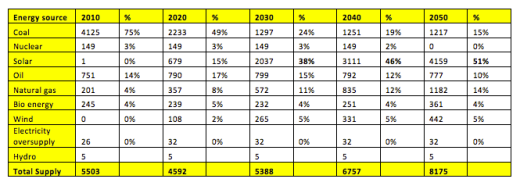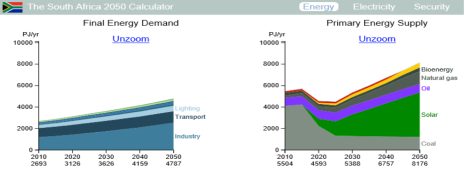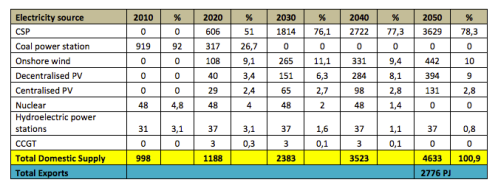Project 90 by 2030 exemplar pathway – developed with online pathways calculator tool
Brief overview
This pathway assumes significant changes to the ‘structure’ or sectoral composition of the economy; with the development of a transparent and robust regulatory and enforcement regime in mind, which is subsequently guided by holistic and participatory sustainable development planning. In addition, this pathway takes into account a shift of social values that highlights positive attributes of individualism and consumerism. The pathway is built on an understanding that strong and effective climate change response is essential for, and can make a significant contribution to, addressing poverty and inequality. The primary objective of this particular pathway is to phase out fossil fuel dependence, with conventional gas assuming a transitional role.
The pathway embraces the electrification of transport given its potential to reduce oil imports and the associated energy efficiency gains. This pathway takes in account significant growth in renewable energy and the development of a sophisticated regional energy distribution network (which may benefit from some new hydropower inputs), together with a national energy investment strategy that values energy security at a regional level. In order for the pathway to be a success, it requires greater regional cooperation and coordination. The pathway endorses the application of ‘smart grid’ designs and technologies, coupled with the implementation of inclusive development strategies that utilise local resources to achieve energy security.
From the perspective of energy demand, energy efficiency is paramount – as a result, most of the efficiency options were selected in the pathway – given the social benefits of improved resource efficiency and the co-benefits of ambitious climate change response. However, a number of efficiency options were not selected in the exemplar calculations, as we anticipated an overlap of efficiency efforts. The reason for not maximising all efficiency options is to emphasise the opportunities of fuel switching. Structural changes to the economy will moderate the growing demand for energy services. At a household level improvements in service delivery is assumed in the short term – with the achievement of universal access to electricity by 2020 (assuming that mini-grids and localised energy generation options play a significant role over this time).
Concentrated Solar Power with thermal storage is prioritised with selection of level 4 (level 4 assumes the highest level of change, whilst level 1 assumes little or no change), even though this provides electricity in excess of national demand, the scale of development supports localisation, with South Africa retaining its spot as one of the world’s top five renewable energy players. As wind energy generation is also prioritised at level 4, at this scale, the generation can be distributed across the Southern Africa region.
Primary Energy Supply in PetaJoules (PJ) and resource shares, at decadal intervals (transcribed from graph):
Introduction
Project 90 by 2030 welcomes this educational tool and its potential contribution to understanding the constraints South Africa must face in determining our energy development pathway and unpacking the complexities of planning for a low carbon economy. We are convinced that our economy must embrace a profound transformation, including a just transition to sustainable energy resources and practices. As an indication of the choices that Project 90 by 2030 is advocating, we have developed an ‘Exemplar Pathway’, which considers a robust inclination towards renewal energy, especially solar development. This Pathway is not an organisational policy or planning recommendation, due to constraints within the levers options available in the on-line version of the tool, but rather an illustrative selection of mitigation actions, as is contained within and can be viewed with the following URL: http://bit.ly/sapathwayscalc-project90
Overview and discussion:
This pathway assumes significant changes from the current ‘structure’ of the economy – the distribution of economic activity across the various sectors – such as stronger growth in the services sector than in commodities supply; the pathway assumes that the share of GDP from extractive industries decreases, thus selecting level 2 of the GDP growth lever, which sees the tertiary sector growing to almost 80% and takes mining from 7.1% in 2006 to 3.7% in 2050 – rather than 5.2% of the economy as in reference case. It also assumes an evolution of social values, with a tempering of individualism and consumerism and a growing emphasis on quality over quantity, as well as the development of a transparent and robust regulatory and enforcement regime, guided by holistic and participatory sustainable development planning. For example, improving provisions for walking, cycling and public transport can significantly reduce transport demand and emissions while improving access to employment and services for a large part of our community.
There is a concerted effort to phase out fossil fuel dependence, assuming eventual acceptance that, like all major coal producers, South Africa cannot responsibly utilise all of its identified coal reserves in the foreseeable future and certainly not this century. The pathway envisages a modest transitional role for gas in the transformation of the energy system, with a cautionary approach to avoiding lock-in to long-term, large scale gas dependence. Electrification of transport is embraced both for the potential to reduce oil imports (by far the largest debit to the national balance of payments) and the energy efficiency gains of restricting the use of internal combustion engines to specific applications for which electric drives (generally up to 3 times more efficient) are not suited. The phasing out of fossil fuels naturally requires massive growth of renewable energy industries and this pathway envisages a programmatic industrial development approach that by the 2040s will provide for export of renewably generated electricity, into an advanced regional grid (which may benefit from some new hydropower inputs without assuming direct transmission to SA) with a national energy investment strategy valuing energy security at a regional level.
On the demand side, given various social benefits of improved resource efficiency additional to climate change mitigation, all efficiency options are utilised, except where we anticipate interaction or overlap of efforts; i.e. under Transport, Vehicle Occupancy remains at level 1, as level 4 is selected for both Modal Share (shift to public transport) and Reduced Travel Demand for passenger transport. Regarding freight transport, the potential for reducing demand growth would merit direct attention, without which, taking both available options to level 3 is conservative. With a rapidly growing number of road users, freight modal shift to rail and a switch to electricity not only offers greater efficiency, but will also reduce overall transport emissions by reducing traffic congestion.
At Household level a major improvement in service delivery is assumed in the near term to achieve universal access to electricity by 2020 assuming that mini-grids and localised options play a significant role (we realise we may miss a 2020 target by a few years, but wouldn’t condone settling for 2030); the rationale for strong energy efficiency and conservation includes improving long-term affordability of energy services.
On the supply side this PATHWAY is premised on greatly enhanced regional cooperation and coordination (e.g. with regional integrated energy planning at SADC level from about 2030, including a regional biomass energy strategy) and with ‘smart grid’ design and technology applied, both for local energy security and inclusive development, and to regional scale transmission development and management. Nuclear power is considered undesirable, as well as prohibitively expensive. Carbon Capture and Storage (CCS) is not considered appropriate for coal-fired power generation, which is largely phased out before 2040; this involves many plants being retired ahead of their scheduled, but out-dated retirement provisions – in most cases instead of the extensive refurbishing that would be required to achieve scheduled plant life and or to comply with air quality regulations. Electricity storage is not directly addressed in the online tool and the inclusion of some new hydropower is selected in this pathway as a surrogate for this, as storage options are likely to become competitive with distant hydropower.
Utilisation of solar power is maximised, with a combination of technologies that prioritises Concentrated Solar Power, with thermal storage. While we recognise that real world development of this technology will start slower and be more modest to 2050 than depicted with this lever at level 4, level 3 does not seek to achieve the optimal scale of development to support localisation and the development of a leading role in this technology, in which South Africa remains amongst the world’s top five players. Similarly, wind capacity at the scale introduced with this lever at level 4 is unlikely to be located entirely in South Africa and should be considered an objective to share with our neighbours.
The choice of Gas supply as modelled here impacts upon the share of energy imported and on costs, but not on the share of gas in national energy supply, and unconventional domestic gas production (shale gas) is not selected or considered sustainable. An increase in gas use is accommodated in the material share for existing Coal-To-Liquids capacity.
Liquid Fuels: The maximum allowed share of 10% biofuels in liquid hydro-carbon fuel supply is considered possible with sustainable production within a pathway in which liquid hydrocarbon fuels play a diminishing role AND with an assumption that this will be part of a necessary regional biofuels strategy embracing land use planning, sound water catchment management and avoiding negative impacts on food security and pricing. Coal-To-Liquids is reduced as much as the tool allows, though a strong case can be made for fully phasing out this technology before 2040, due to its exceptionally large ecological footprint and poor economics. CCS on liquid fuels is not selected, as a shift away from liquid hydrocarbons is prioritised and if safe and affordable CCS opportunities become available the best value proposition would be to apply this technology to industrial process emissions.
Electricity export:
Our energy supply PATHWAY includes large electricity exports by 2050: about 60% (2 776 units according to the Flow diagram) out of 4633 PJ of electricity supplied in 2050, as the installed capacity with CSP at level 4 is taken to a level well above that required for domestic supply (to decarbonise electricity supply by 2050, the online Calculator requires choosing one of the large scale solar options i.e. CSP or centralised PV, at level 4); the provisions for export is not a characteristic required by Project 90 by 2030 for this exemplar Pathway, but a by-product of selecting levels to achieve phasing out of coal-fired generation. This also means that while solar accounts for 51% of the total primary energy supply mix, it accounts for a much smaller share of the domestic supply mix; this applies to all renewables, as they account for all electricity supply (for domestic use and export).
Final Energy Demand and Primary Energy Supply
Note: The dip in primary supply reflects a massive reduction in transformation losses as a result of very rapid phasing out of coal in electricity supply.
Electricity Supply in PetaJoules (PJ) and resource shares, at decadal intervals (transcribed from graph):
Electricity Supply: our selection assumes that Concentrated Solar Power (CSP) with thermal storage becomes the mainstay of bulk electricity supply nationally, with extensive capacity quite quickly becoming available for export. It would be reasonable to expect this to take longer than this lever setting suggests and for some portion of the proposed large-scale renewable energy capacity to be located in neighbouring countries, e.g. Namibia, (a broad regional spread of wind capacity optimises aggregate resource use) but it is accepted in this Pathway as regional integration is anyway an essential characteristic of this Pathway.




